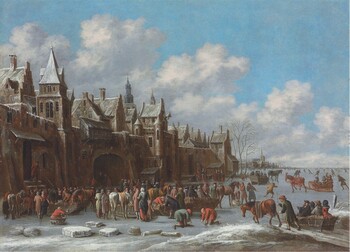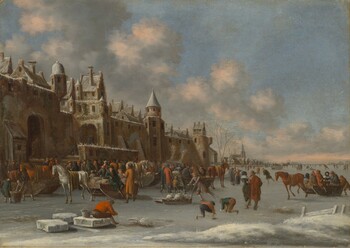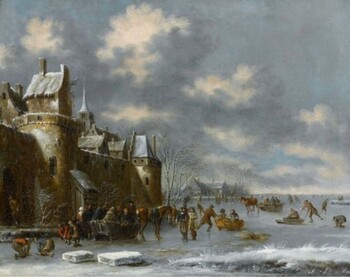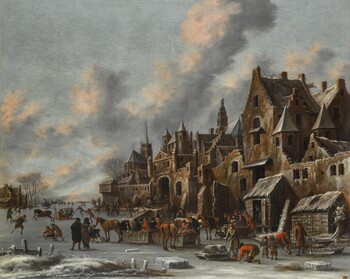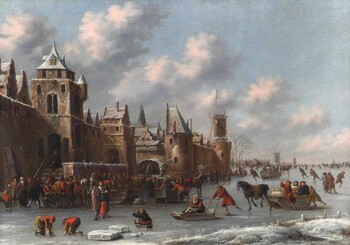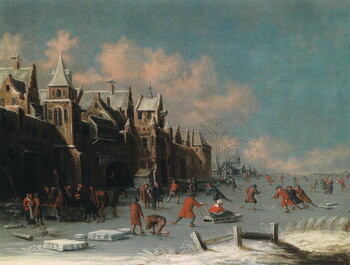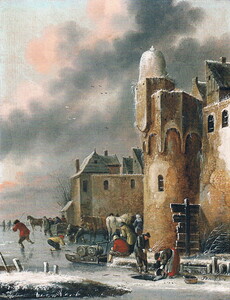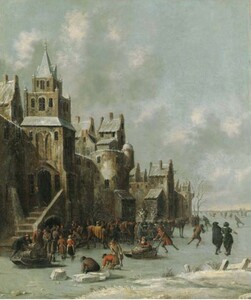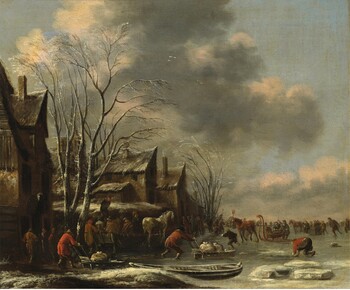17.500 €
Winter pleasures outside the ramparts of a town
Oil on canvas : 61,0 X 83,9 cm
Signed and dated lower right THMANS 1689”
(THM linked)
Frame : 74,2 X 97,8 cm
In short
Our sweeping winter vista ranks amongst Heeremans’ best and most detailed winter landscapes. From circa 1550 until circa 1850 Europe suffered under a small ice age. Two thirds of the winters in the Low Countries between 1600 and 1700 were very cold with long periods of frost and snow. This explains the popularity of ice skating and sledding, and its representation in paintings and engravings during the 17th century.
About Thomas Heeremans
Dutch painter
Haarlem 1641 – 1697 Haarlem
Heeremans specialized in summer and winter landscapes with numerous figures enjoying themselves. There are also a few beach scenes set into the dunes.
He was a pupil of the classicising history and portrait painter Cesar Boetius van Everdingen, who was active in Haarlem between 1648 and 1658. While van Everdingen’s influence seems to have very little on Heeremans, he became strongly influenced by the work of the slightly earlier Haarlem painter Klaes Molenaer (Haarlem before 1630 – 1676 Haarlem).
Heeremans’ earliest dated painting is from 1644. He became a member of the Painter's Guild of Saint Luke of Haarlem in 1651. Both Heeremans and Molenaer specialised in representations of every day outside activities and of moments of leisure of the population of the countryside and small towns of the Dutch Republic.
Heeremans became member of the painters’ guild of Saint Luke in 1664.
He seems to have been active his complete career in Haarlem.
Dated works known between 1660 and 1694.
About our painting
Heeremans painted fictitious views of ice skaters outside a small village or outside the ramparts of a small town, clearly inspired by his home town Haarlem. He also painted many summer scenes set in small, unidentifiable villages of Holland. Just one of these small places, Medemblik, has been identified in a painting, formerly in London with the Adam Jacobs Gallery.
North-Western Europe went through a small ice age from circa 1550
until the middle of the 19th century. Two thirds of the winters in Holland between 1600 and 1700 were very cold with long periods of frost and snow. Especially the winters of 1662-63 and of 1671-72 were very cold; January 1684 must have been the coldest month of that century.
Heeremans frequently used the “THMans” signature.
Why should you buy this painting?
Because it is a magnificent example of the detailed art of Heeremans’ winter scenes: against a luscious architectural background one sees a busy mix of people ice-skating and driving over the ice in sleighs, others are loading goods, while people close to the city walls are waiting for the ferry to take them over the ice.
Comparative paintings
Click photos for more details

